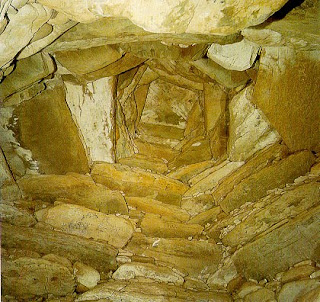We took a daytrip from Dublin to see some of the rural, ancient treasures in the area. For this trip, we took a guided bus tour from Dublin. This was the only guided bus tour we took all year (the rest of the daytrips we did on our own using public transportation). But we heard that this particular tour was excellent (there was a limit at 20 people), and the locations we went to are impossible to reach by public transport. So guided tour it was.
The guided tour was indeed excellent, so I’ll mention the name here: Mary Gibbons tour. Mary herself guides the tour, and she seems to be a bit of a history buff.
Hill of Tara
First, we stopped at the Hill of Tara – just looks like an open green space now, but this has been a historically significant hotspot for many millennia. There are ruins from many periods of history, starting with the stone age (5,000 years ago), and including iron age ruins, Roman ruins (2,000 years ago), and medieval artifacts. It has been a seat of kings and coronation ground for many centuries (142 kings crowned there) – it lost some of its significance in 600 AD (after St. Patrick’s time, when Christianity spread through Ireland and the pagan rituals were lost). Tara fell into complete oblivion in 1169 after the Norman invasion.
Here is the entire space – the hill affords a 360-degree view, and one can see 23 of Ireland’s 32 counties (a couple hundred miles).
There are these strange mounds where building foundations and burial mounds used to be, but are now covered by grass:
These two monuments are at the top of the hill. The one on the right is the Stone of Destiny – legend has it that all of the kinds of Ireland were crowned here, until 500 AD. It is unclear exactly how old the stone is – the Celtic legend is that “in antiquity,” a semi-divine race brought it to Ireland.
The other carved stone is from 1798 and commemorates the loss of lives in the Irish rebellion that was put down by the English military.
This is a Neolithic Burial mound (with stone structure inside) that was built about 5,400 years ago. It is aligned to let the sun’s rays in the passage on Nov 8th and Feb 4th. Although it is not as big or impressive as other solstice/equinox passages, it was big & accurate enough to track the alignment of the sun & changing seasons.
Newgrange
Next stop: Newgrange. It is hard to exaggerate the archaeological significance of this place. It is the oldest building in Europe. It’s the oldest astronomical observatory completely intact. It is 500 years older than the great pyramids of Egypt. It was built without mortar and it’s still standing. It’s about 5,000 years old, and it was designed such that the sun’s rays shine down the passage for 5 minutes, once a year (Winter Solstice) – down a 60-foot passage. The rays illuminate a small cove, where cremated human remains were most likely buried. The small window and gentle uphill grade of the passage were specially engineered for the alignment.
It’s just really impressive that such accurate engineering was calculated during the stone age.
One note: the burial mound itself and the interior stone structure are exactly as it was found. However, the small white rocks that form the cylindrical frame around the mound are not as they were found. The rocks were scattered around the site, and have been reconstructed according to how they were “likely” placed one day, based on the probable trajectory of their tumble. These same rocks did once form a façade of the mound, but it is questionable as to whether they were in the exact formation as they have been reconstructed. The reconstruction of these stones is controversial.
Newgrange from the side:
So, to recap, these same stones were in some arrangement on the façade of the mound, but possibly not in this precise arrangement.
Newgrange from the front:
Detail of the entrance. The rock in front was carved a few centuries after the structure was built, likely between 4,500 and 4,000 BC. Behind, the entrance doorway is partially hidden, and the small “window” above it is where the sun’s rays shine through for 5 minutes at the winter solstice.
Around the outside of the mound, these carved rocks are arranged. There are many theories about possible meanings of the carvings (religious, astronomical, agricultural, etc), but these are all speculations, since no records or explanations of these carvings exist. (oooh, mysterious)
We were allowed to enter the passage and the burial space! Unfortunately, we were not able to take pictures inside. These pictures are from the website.
This is part of the passageway, with some stone age art.


No comments:
Post a Comment